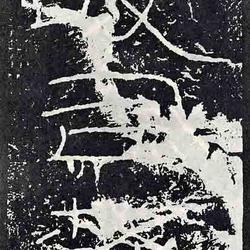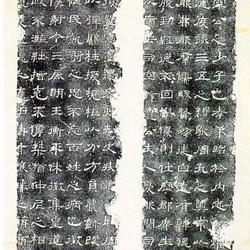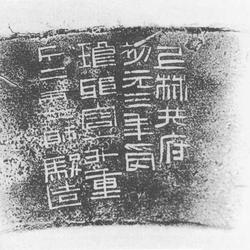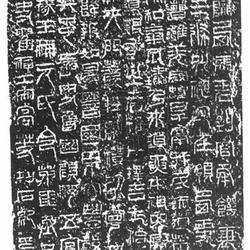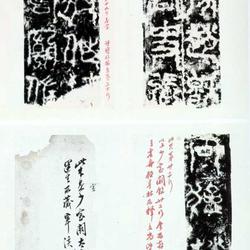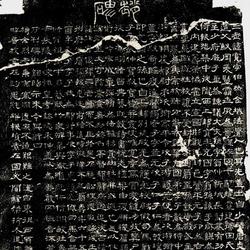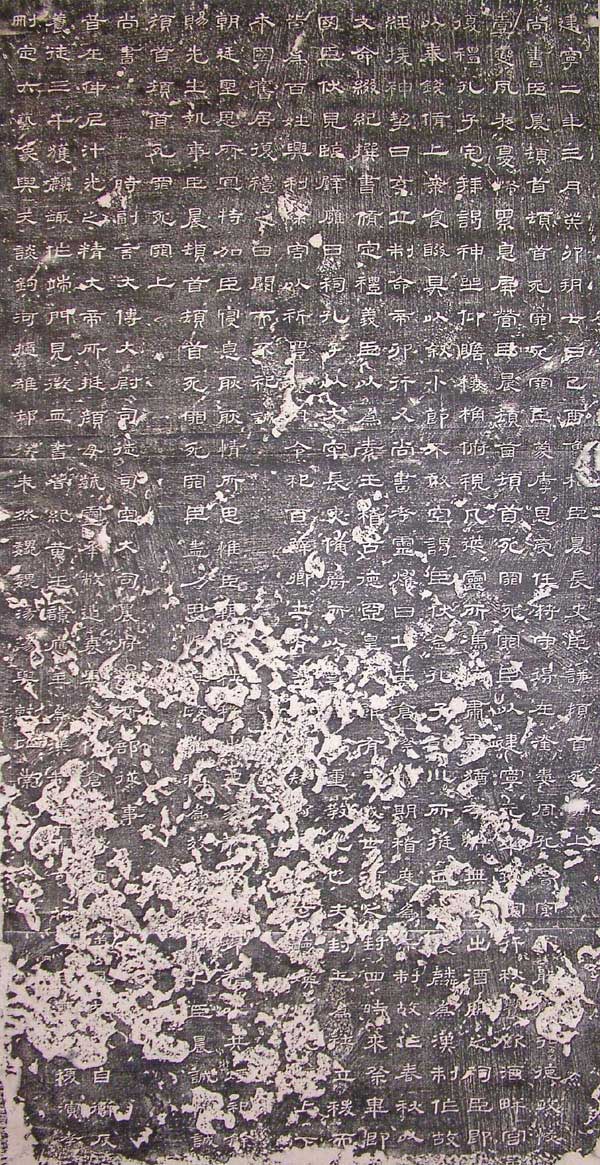
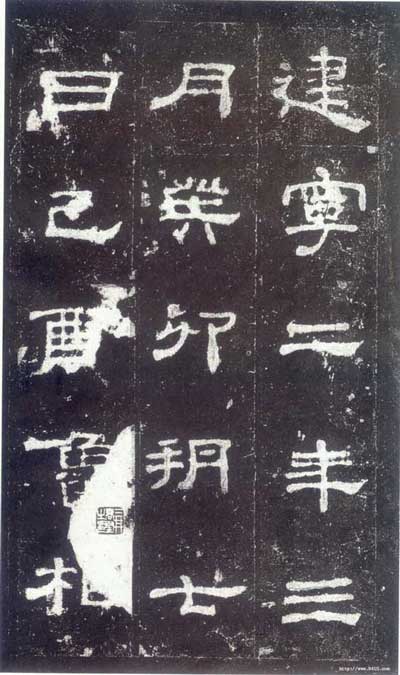
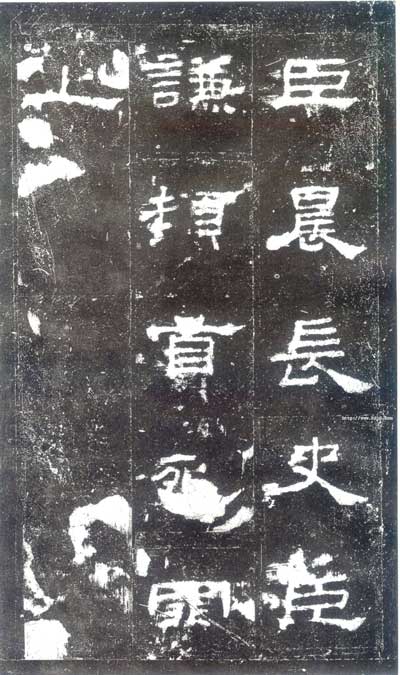
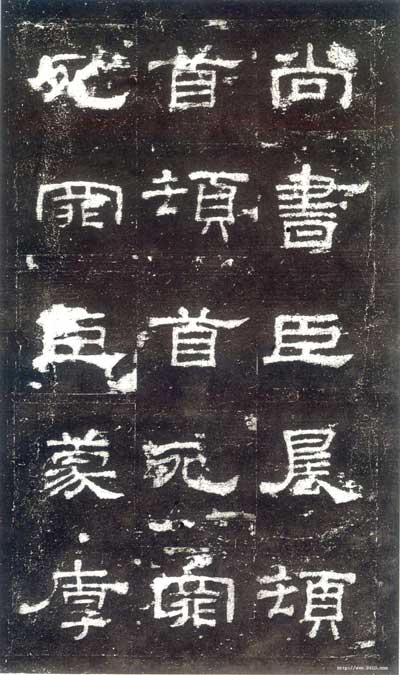
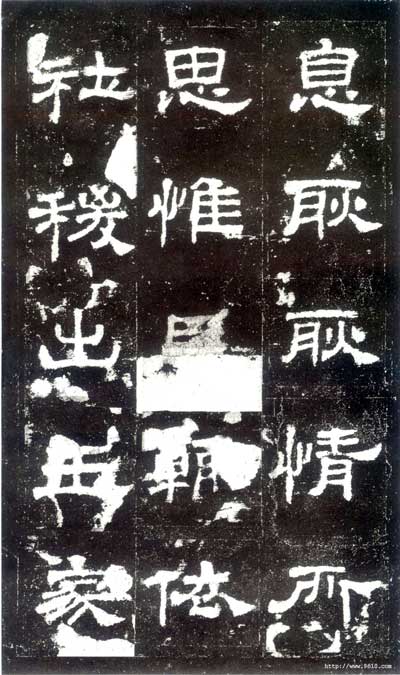
Official script of the Eastern Han Dynasty. This monument is two monuments carved on one stone. It is also called "Shi Chen's front and back stele", "Shi Chen's front stele" and "Shi Chen's back stele". Emperor Ling of the Eastern Han Dynasty was established in the second year of Jianning (169). Official script. The front and back are divided into the main carving and the negative carving of the stele. The full name of the main inscription on the stele is "The Inscription of the Morning Sacrifice of Confucius by the Prime Minister of Lu", which is called "The Inscription of the Morning Sacrifice of Confucius", commonly known as "The Inscription". The full name of the inscription on the stele is "Stele of Lu Prime Minister Shi Chen's Dinner in Confucius Temple", which is also called "Stele of Shi Chenhou". The monument is in the Confucius Temple in Qufu, Shandong. The content records the facts of the activities of respecting and worshiping Confucius at that time. Because the construction of walls and ditches, the establishment of city planting and planting, and the appointment of officials were all carried out in sequence and were not one-time activities. Therefore, although there are big differences between the last and last words of "Shi Junxi" in "Hou Bei", Both monuments were written by one person. This stele, together with "Liqi" and "Yi Ying", are known as the three famous stele of Confucius Temple. Wanjing of the Qing Dynasty commented on the calligraphy of this stele in his book "Fen Li Oucun" as "the order is closely repaired and the order is sharp", "its character should be reflected in the "History of Death" (Yi Ying Stele) and "Han Chi" (Liturgical Stele) ) on the right." Fang Shuo commented that "the calligraphy is solemn and profound, profound in ancient times, with both structure and meaning. It is the product of temples and eighty-nine authentic." The inscription on the stele is almost a thousand words, and the atmosphere is peaceful and solemn. It is one of the famous Han dynasty steles with its refined brushwork and simple and thick brushwork. Kang Youwei commented that this stele is of the Xuhe type. It has a graceful and elegant style among the Han stele in Fengli script. The writing technique is two or three points, and the folded strokes tend to be rounded, soft and smooth. It is a regular pattern for later generations to imitate. There are many rubbings of this stele, more than a hundred of which were made from the early Ming Dynasty to the middle Qing Dynasty alone. It can be seen that it is impossible to call it a masterpiece of Han stele.
The Han Dynasty stele takes the ancient meaning as its priority. This stele is more ancient than Fenli. It is so natural and implicit that it requires both "fa" and "meaning". Yang Shoujing, a modern calligraphy critic, commented on this stele in "Ping Bei Ji": "If people say that not all Han Dynasty official scripts are good, but that a kind of ancient and thick spirit is unattainable, this is true." Many people who visited the stele in later generations said With its large number of characters and solemn rules, this stele is one of the most masterpieces in Han official script and is regarded as an introductory model for learning to write official script.
When learning to write official script, first note that official script has square and round pens. The difference between the two mainly lies in the starting, closing and folding of the strokes in horizontal drawing. The thickness of the horizontal strokes represents the change in the strength of the pen used to lift the strokes. The horizontal strokes in official script are horizontal and flat, creating a sense of stability in official script. Regular script also talks about horizontal horizontal strokes, but regular script horizontal strokes generally have a slope that is lower on the left and higher on the right. When writing official script, you should avoid writing in regular script. When there are multiple horizontal lines that overlap in a word, the spacing should be basically equal, and the length of each horizontal line can be different. For example, the word "etc." in the stele has four horizontal layers. In addition to varying lengths, there are also artistic treatments of slightly upper and lower arcs on the lower two horizontal layers. Vertical drawings play the role of pillars in characters and require strength, stability, solidity and strength. The vertical paintings in each character of this stele stand vertically. But avoid being dull and clumsy. If there are two vertical lines juxtaposed in a word, it should be written like the treatment in this stele. The middle vertical line can be written with a heavy emphasis on the top and a light weight on the bottom. The wave strokes in the inscriptions on this stele are wonderful. Bo Teng strokes are divided into left and right strokes in the structure of official script. Pay attention to their differences. Sometimes it is like the wings of a flying bird spreading out smoothly and vividly. The characteristic of pointillism is the extremely contracted and condensed lines of the strokes in the characters, which contrast with the long strokes, giving the knotted characters a lively charm. Mrs. Wei defined the momentum for the points, "like a falling stone from a peak," as in the traditional Chinese stele The character "qi" in the Chinese character "Qi" has a total of nine dots in different shapes. There are many other characters with multiple dots, some turn lines into dots, and some turn dots into lines. No matter what kind of dots, they are all changeable. , rich in multi-style, making the characters with dots full of life. As for other strokes such as hook painting, long flat strokes, etc., there are only a few examples. There are also compound characters, which account for the majority of Chinese characters, with their own complexity of strokes and structures. As long as you use a different balance of the structure methods required for each character, draw inferences from one instance and get the gist, you will be able to master the use of pens from many aspects. and structural specific regulations. (Commentary: Zhang Qianchao)

